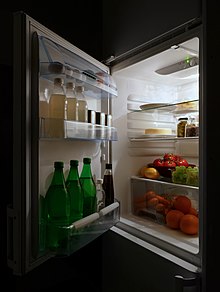
Back Yskas AF ማቀዝቀዣ AM Frigorifico AN ثلاجة Arabic Nevera AST Soyuducu AZ Һыуытҡыс BA Eiskostn BAR Халадзільнік BE Халадзільнік BE-X-OLD


A refrigerator, colloquially fridge, is a commercial and home appliance consisting of a thermally insulated compartment and a heat pump (mechanical, electronic or chemical) that transfers heat from its inside to its external environment so that its inside is cooled to a temperature below the room temperature.[1] Refrigeration is an essential food storage technique around the world.[2] The low temperature lowers the reproduction rate of bacteria, so the refrigerator reduces the rate of spoilage. A refrigerator maintains a temperature a few degrees above the freezing point of water. The optimal temperature range for perishable food storage is 3 to 5 °C (37 to 41 °F).[3] A similar device that maintains a temperature below the freezing point of water is called a freezer.[4] The refrigerator replaced the icebox, which had been a common household appliance for almost a century and a half. The United States Food and Drug Administration recommends that the refrigerator be kept at or below 4 °C (40 °F) and that the freezer be regulated at −18 °C (0 °F).[5]
The first cooling systems for food involved ice.[6] Artificial refrigeration began in the mid-1750s, and developed in the early 1800s.[7] In 1834, the first working vapor-compression refrigeration, using the same technology seen in air conditioners, system was built.[8] The first commercial ice-making machine was invented in 1854.[9] In 1913, refrigerators for home use were invented.[10] In 1923 Frigidaire introduced the first self-contained unit. The introduction of Freon in the 1920s expanded the refrigerator market during the 1930s. Home freezers as separate compartments (larger than necessary just for ice cubes) were introduced in 1940. Frozen foods, previously a luxury item, became commonplace.
Freezer units are used in households as well as in industry and commerce. Commercial refrigerator and freezer units were in use for almost 40 years prior to the common home models. The freezer-over-refrigerator style had been the basic style since the 1940s, until modern, side-by-side refrigerators broke the trend. A vapor compression cycle is used in most household refrigerators, refrigerator–freezers and freezers. Newer refrigerators may include automatic defrosting, chilled water, and ice from a dispenser in the door.
Domestic refrigerators and freezers for food storage are made in a range of sizes. Among the smallest are Peltier-type refrigerators designed to chill beverages. A large domestic refrigerator stands as tall as a person and may be about one metre (3 ft 3 in) wide with a capacity of 0.6 m3 (21 cu ft). Refrigerators and freezers may be free-standing, or built into a kitchen. The refrigerator allows the modern household to keep food fresh for longer than before. Freezers allow people to buy perishable food in bulk and eat it at leisure, and make bulk purchases.
- ^ Peavitt, Helen (15 November 2017). Refrigerator: The Story of Cool in the Kitchen. Reaktion Books. p. 8. ISBN 978-1-78023-797-8.
- ^ Aung, Myo Min; Chang, Yoon Seok (11 October 2022). Cold Chain Management. Springer Nature. p. 46. ISBN 978-3-031-09567-2.
- ^ . Keep your fridge-freezer clean and ice-free. BBC. 30 April 2008
- ^ R, Rajesh Kumar (1 August 2020). Basics of Mechanical Engineering. Jyothis Publishers. p. 117. ISBN 978-93-5254-883-5.
- ^ . Are You Storing Food Safely? Archived 5 March 2022 at the Wayback Machine FDA. 9 February 2021
- ^ Accorsi, Riccardo; Manzini, Riccardo (12 June 2019). Sustainable Food Supply Chains: Planning, Design, and Control through Interdisciplinary Methodologies. Academic Press. p. 189. ISBN 978-0-12-813412-2.
- ^ Traitler, Helmut; Dubois, Michel J. F.; Heikes, Keith; Petiard, Vincent; Zilberman, David (5 February 2018). Megatrends in Food and Agriculture: Technology, Water Use and Nutrition. John Wiley & Sons. p. 120. ISBN 978-1-119-39114-2.
- ^ Yahia, Elhadi M. (16 July 2019). Postharvest Technology of Perishable Horticultural Commodities. Woodhead Publishing. p. 212. ISBN 978-0-12-813277-7.
- ^ Zhang, Ce; Yang, Jianming (3 January 2020). A History of Mechanical Engineering. Springer Nature. p. 117. ISBN 978-981-15-0833-2.
- ^ O'Reilly, Catherine (17 November 2008). Did Thomas Crapper Really Invent the Toilet?: The Inventions That Changed Our Homes and Our Lives. Skyhorse Publishing, Inc. ISBN 978-1-62873-278-8.